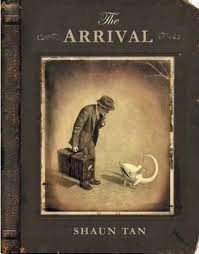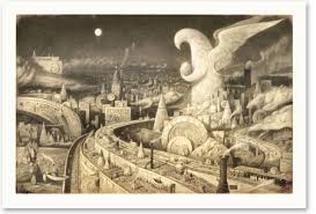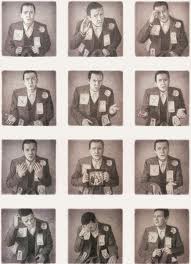Introduction
This term we are going to explore the themes of migration and refugees through literature. Some of these will be picture books and others will be novels.
We are going to start with an amazing, awarding winning, graphic novel by Shaun Tan. You may have seen it in our library before.
What is a graphic novel?
Discuss with the students what they think is a graphic novel?
What are the elements of a graphic novel?
Is a graphic novel easy to read?
Is there only one interpretation of a graphic novel?
Some people say that a graphic novel is a book that is for everyone. Why might people say this?
A graphic novel is often a very rich and layered text with many interpretations, depending on who is 'reading' the text. It often requires many readings to really grasp all that is happening and you will often discover new things every time you read it. Shaun Tan is a brilliant author, using the medium of art to tell the story. He uses visual elements to convey feelings of the characters and the mood of the story.
In the library today you will only scratch the surface of this truly amazing work of art.
We are going to start with an amazing, awarding winning, graphic novel by Shaun Tan. You may have seen it in our library before.
What is a graphic novel?
Discuss with the students what they think is a graphic novel?
What are the elements of a graphic novel?
Is a graphic novel easy to read?
Is there only one interpretation of a graphic novel?
Some people say that a graphic novel is a book that is for everyone. Why might people say this?
A graphic novel is often a very rich and layered text with many interpretations, depending on who is 'reading' the text. It often requires many readings to really grasp all that is happening and you will often discover new things every time you read it. Shaun Tan is a brilliant author, using the medium of art to tell the story. He uses visual elements to convey feelings of the characters and the mood of the story.
In the library today you will only scratch the surface of this truly amazing work of art.
Look at the front cover

Consider the title and the image on the front cover.
Who do you think is arriving in this picture? Why
What does the colour and the design of the cover tell you about the time this story might be set in?
What do you think is happening between the two 'characters ' on the front cover? What do they think of each other?
Why might they be so different?
Turn to the end pages on the inside cover.
Can you connect these different faces with the theme of 'arrival'
Who do you think is arriving in this picture? Why
What does the colour and the design of the cover tell you about the time this story might be set in?
What do you think is happening between the two 'characters ' on the front cover? What do they think of each other?
Why might they be so different?
Turn to the end pages on the inside cover.
Can you connect these different faces with the theme of 'arrival'
Read the story together
Use the visualiser to read through the story in pictures. This could take some time and you may not finish this in the library today. This lesson can be continued as you wish back in the classroom.
The first chapter tells a story of migration. A family is separated when the father leaves first to journey to a new land (the destination is deliberately unknown). After reading chapter 1, watch the first video below which is a student's response to the images used in that chapter with music. It would be a good way to see the images more clearly and consolidate the first part in the story.
The second chapter tells of the father's journey and arrival in a new and foreign country. Everything is alien to him and we can feel how out of place and overwhelmed he is feeling. He is often lost and confused by things. Language is a barrier. He settles in his new lodgings. Take notice of what he does when he settles in to his rooms.
The third chapter tells of his experiences trying to get around the new city. He meets another couple of immigrants who have arrived for different reasons. They help him to understand some of the things which are strange to him. He makes connections and starts to feel more comfortable in his new land.
The fourth chapter shows his experiences in looking for work. Once again he meets others who have gone through hardships just as he has done.
Chapter five shows the passing of time and the longing to have his family with him again and finally their arrival too.
The final chapter reveals the beginning of their new life as a family. It shows the cycle of arrival beginning again, when the daughter meets and helps a new person
The first chapter tells a story of migration. A family is separated when the father leaves first to journey to a new land (the destination is deliberately unknown). After reading chapter 1, watch the first video below which is a student's response to the images used in that chapter with music. It would be a good way to see the images more clearly and consolidate the first part in the story.
The second chapter tells of the father's journey and arrival in a new and foreign country. Everything is alien to him and we can feel how out of place and overwhelmed he is feeling. He is often lost and confused by things. Language is a barrier. He settles in his new lodgings. Take notice of what he does when he settles in to his rooms.
The third chapter tells of his experiences trying to get around the new city. He meets another couple of immigrants who have arrived for different reasons. They help him to understand some of the things which are strange to him. He makes connections and starts to feel more comfortable in his new land.
The fourth chapter shows his experiences in looking for work. Once again he meets others who have gone through hardships just as he has done.
Chapter five shows the passing of time and the longing to have his family with him again and finally their arrival too.
The final chapter reveals the beginning of their new life as a family. It shows the cycle of arrival beginning again, when the daughter meets and helps a new person
The following two videos are short interviews with Shaun Tan. Shaun talks about the themes in his book and what he has done to express ideas about multiculturalism and migration. He also talks about The Arrival as a book that anyone can read. It is interesting to think about how a deaf person's experiences can be likened to an immigrant's experiences in a strange place.
|
Click on the My Place button below to watch a small excerpt from the series. This segment shows how difficult communication can be for immigrants to a new country. Shaun Tan depicted this in his book too. Look at the picture to the left. What emotions is the arrival displaying?
|
Author's Purpose
Finally, consider the reason that Shaun Tan wrote this book.
What message about immigration and migrants is he wanting to get across to the reader of this book?
What reasons does he give for people migrating to a new country?
What does he want us to know about those experiences?
What message about immigration and migrants is he wanting to get across to the reader of this book?
What reasons does he give for people migrating to a new country?
What does he want us to know about those experiences?

Why does he draw the new country so strangely and so alien looking?
Look at other images in the book of buildings, machines, roads, transport and so on. Why has he drawn them so that they don't look at all familiar. What is his purpose in exaggerating the differences in these everyday things that we need to navigate?
Look at other images in the book of buildings, machines, roads, transport and so on. Why has he drawn them so that they don't look at all familiar. What is his purpose in exaggerating the differences in these everyday things that we need to navigate?
